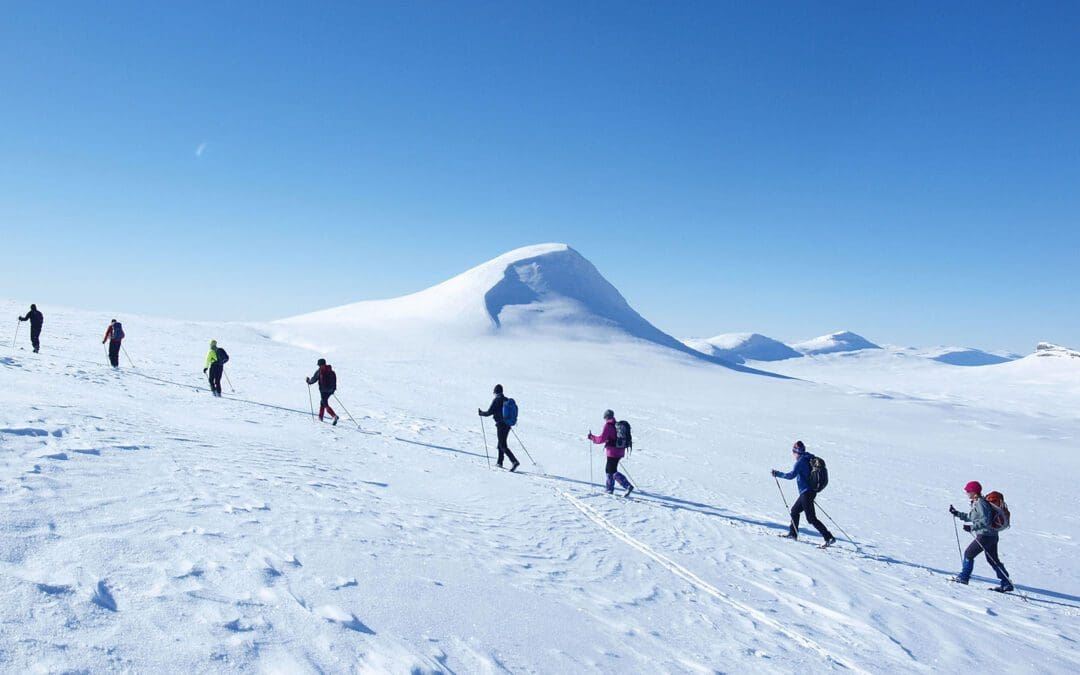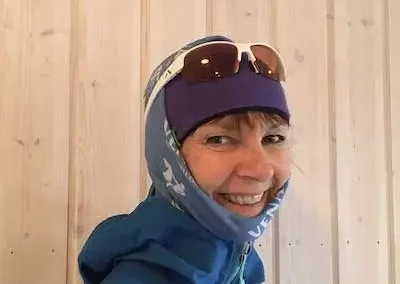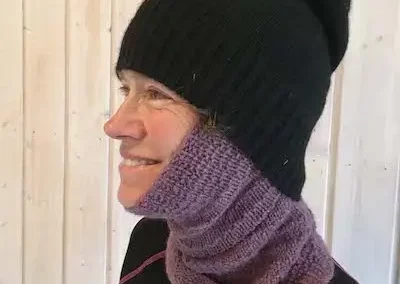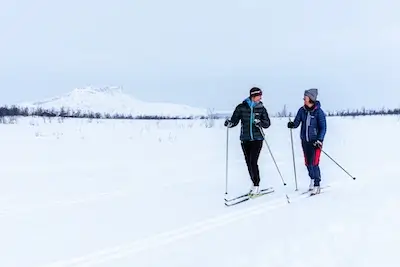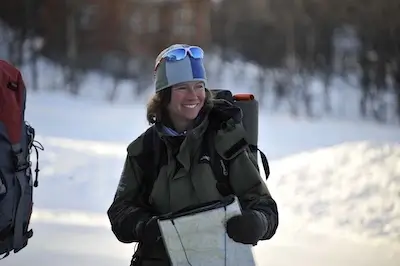Following on to the previous article what to wear for cross country skiing in Norway in this article I’ll share some of the tricks that the Venabu ski guides use to stay comfortable while cross country skiing.
Top tips in a nutshell:
- The cross country ski “buff balaclava” is a beautiful thing
- Aim to minimise “faff”
- Sunglasses can be worn over hats or headbands
- Consider tops that have a hood
- Carry spare pairs of gloves
- Duvet jackets are very useful!
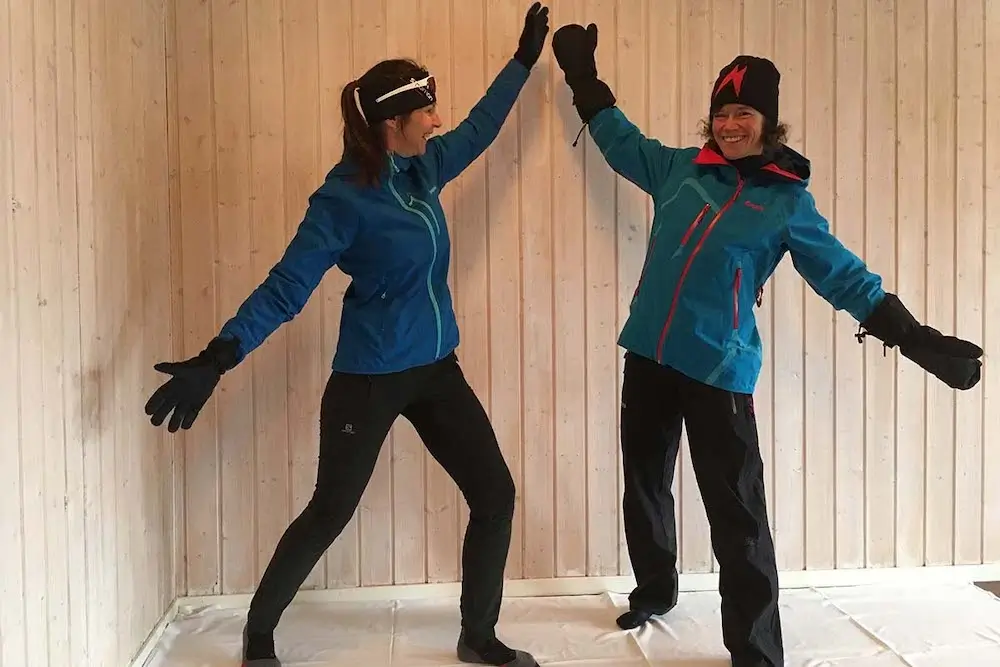
The buff balaclava
In the photo, on the left in the gallery above, Wenche is modelling version 1 (see below) of the buff balaclava. This is a really useful trick on particularly cold or windy days.
How to create version 1. See the left hand gallery photo above.
- Put your buff around your neck.
- Pull the back of your buff up over the back of your head and over the crown of your head, so the front of your buff sits under your chin.
- Then put your hat on over the buff and hey presto!
I have seen Wenche then add a second buff around her neck to tuck down into her jacket. Yep, looks a little reminiscent of a medieval knight but it works ☺
To create version 2. See the right hand gallery photo.
- Put your buff around your neck then put on your hat.
- This time pull the buff up over your head and hat, and fold the front of the buff under your chin.
Similar to the first version but this time the buff is outside your hat. I prefer this version 2 because once I’m moving I tend to warm up quite quickly. Version 2 allows me to put the buff down round my neck and not overheat – all with with minimal ‘faff’, see below.
I like to use a thin buff – just like our Venabu branded ones ☺ because the thinner fabric is super-flexible and ‘moulds’ to the shape of my head. This keeps me cosy and I don’t overheat.
Keeping your nose warm
I also find that when I wear the buff balaclava my nose stays warm – without having to cover my nose and mouth. If you wear a buff or scarf over your mouth this tends to get the buff/scarf wet = chilly, brr, and your sunglasses can fog up too.
Minimising ‘faff’
Minimising ‘faff’ and ‘faffing’ ☺ is one of the key top tips for staying comfortable when exercising outdoors. If it’s easy for you to regulate your temperature, without stopping or taking off your rucsac, you are more likely to do so. Make small, timely adjustments and stay comfortable. Shoving a hat in a pocket, adjusting a hood and using ‘pit zips’ in a shell jacket are all examples of quick, faff-free adjustments that can really help.
Sunglasses worn over the hat or headband
Wearing sunglasses with the arms over the outside of your hat or headband minimises glasses fogging up. This won’t be good for your glasses if your hat or headband is very thick but over a sporty cross country ski hat it should be fine. You may have seen this look. Rather than just being an affectation or ‘too cool for school’, it does actually work.
Having the glasses’ arms a little away from the side of your head helps air to circulate. The alternative is being ‘sealed in’ with a hat down over the forehead, close to the sides of the face and over the glasses’ arms. If your hat/headband is thick and knitted it may be possible to push the arms of the glasses through the knit without harm. Worth experimenting with, in front of a mirror, at home?
Choosing tops/jackets with hoods
Hooded jackets are a firm favourite of mine, even as an underlayer. They zip up under the chin, adding warmth that way. If the wind picks up or it’s a bit chilly when starting out, but you’re likely to warm up, a hood adjustment quickly gices faff-free temperature regulation.
Carrying more pairs of gloves or mitts
This was a top tip I heard years ago in a lecture at Glenmore Lodge, Scotland. It proved revolutionary to me, as someone whose hands get cold. The guides working at ‘The Lodge’, in Scotland’s Cairngorms, know a thing or two about keeping warm in tricky winter conditions.
They suggested taking one, two or even three spare pairs of gloves or mitts (carried in a dry bag in your rucsac) out onto the hill. The dry, crisp winter conditions you may experience in Norway do differ from occasionally claggy Scottish weather, but the principle is the same.
On ski tours here at Venabu I carry a spare warm pair of mitts or gloves as back up. On long day tours, like our Ski Safari off track days, I’ll take an ‘uphill’ or morning pair and a second pair to change into after the harder work or at lunchtime. I still have the back up warm pair with me, just in case.
Carrying a ‘belay’ duvet jacket – synthetic or down?
As a spare warm layer for lunches, longer snack stops or in case of emergency a ‘belay’ duvet jacket works really well. This term ‘belay jacket’ comes from climbing. During a climb each climber will spend some time at a ‘belay’, or stopping point, while their partner is climbing. In winter this can be chilly/unbelievably cold! The solution is to put on a jacket that goes over everything else that you are wearing, even your shell jacket. The belay jacket is quickly taken off and stuffed away when it’s your turn to move. This is easy, less faff, and you don’t lose any heat by taking the outer shell layer on and off.
In the UK or damp conditions it may be best if your belay jacket has a synthetic fill, so it still insulates even when soggy. I’ve found a synthetic belay jacket to be outstanding when hillwalking in the UK. The jacket can be put on over everything, even in rain, and it keeps you toasty warm.
In reliably dry, snowy conditions a down jacket is perfect and weight-for-weight will be warmer. However, if it gets damp it won’t insulate effectively. While a down jacket may be the best spare layer for cross country skiing in Norway (during the coldest weeks), a good synthetic jacket may have more cross over value if you are here in warmer weather. You’ll have a useful item for the UK hills or summer trekking in the Alps.
“Excellent guiding team!”
“An amazing week. The whole guiding team was excellent and very patient for me as a beginner. Music in the evening and a relaxed, friendly atmosphere. Hope to be back soon.”
Josephine (UK)
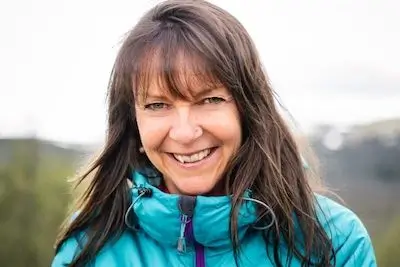
Joy O’Flanagan is an experienced BASI Nordic Ski Instructor and International Mountain Leader. She is also a movement specialist: a qualified physiotherapist and Pilates instructor.

